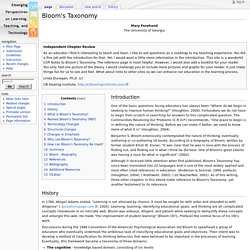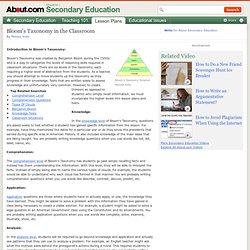Bloom's Taxonomy
Manualcontents.pdf (application/pdf Object)
Bloom's Taxonomy. Mary Forehand The University of Georgia Introduction One of the basic questions facing educators has always been "Where do we begin in seeking to improve human thinking?

" (Houghton, 2004). Fortunately we do not have to begin from scratch in searching for answers to this complicated question. The Communities Resolving Our Problems (C.R.O.P.) recommends, "One place to begin is in defining the nature of thinking. Benjamin S. Although it received little attention when first published, Bloom's Taxonomy has since been translated into 22 languages and is one of the most widely applied and most often cited references in education.
History In 1780, Abigail Adams stated, "Learning is not attained by chance; it must be sought for with ardor and attended to with diligence" ( quotationspage.com, 2005). The cognitive - knowledge based domain, consisting of six levels The affective - attitudinal based domain, consisting of five levels, and The psychomotor - skills based domain, consisting of six levels.
Levels of Questions in Bloom's Taxonomy: Teaching Methodoly Advice. Use these levels of questions to challenge students in all grade levels with various types of questions as defined by Bloom's Taxonomy. They will be doing higher-level thinking and you will have a more interesting classroom! This Bloom's Taxonomy resource includes an in-depth discussion of the different levels of questioning with suggested examples to help you form your own higher-level questions to use in your classroom. The goal of classroom questioning is not to determine whether students have learned something (as would be the case in tests, quizzes, and exams), but rather to guide students to help them learn necessary information and material. Questions should be used to teach students rather than to just test students! Teachers frequently spend a great deal of classroom time testing students through questions. Jabberwocky Taxonomy is an orderly classification of items according to a systematic relationship (low to high, small to big, simple to complex).
Fire Alarm Knowledge Application. Body1.pdf (application/pdf Object)
Lesson Plans and Tests Using Blooms Taxonomy. Introduction to Bloom's Taxonomy: Bloom's Taxonomy was created by Benjamin Bloom during the 1950s and is a way to categorize the levels of reasoning skills required in classroom situations.

There are six levels in the taxonomy, each requiring a higher level of abstraction from the students. As a teacher, you should attempt to move students up the taxonomy as they progress in their knowledge. Tests that are written solely to assess knowledge are unfortunately very common. However, to create thinkers as opposed to students who simply recall information, we must incorporate the higher levels into lesson plans and tests.
Knowledge: In the knowledge level of Bloom's Taxonomy, questions are asked solely to test whether a student has gained specific information from the lesson. Comprehension: The comprehension level of Bloom's Taxonomy has students go past simply recalling facts and instead has them understanding the information. Application: Analysis: Synthesis: Evaluation: Citation: Bloom, B.
BloomQuestions_000.pdf (application/pdf Object)
Applying Bloom's Taxonomy.


